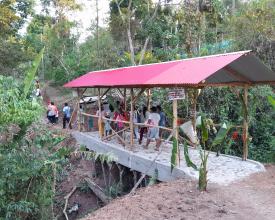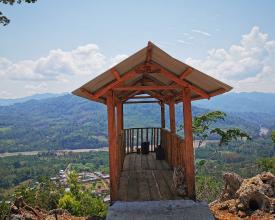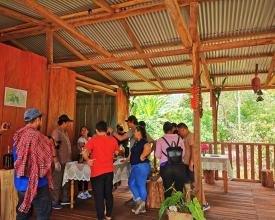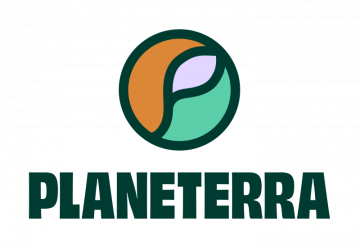
Fund-for-Employment mechanism to promote community-based tourism and ensure direct economic income for the local population.
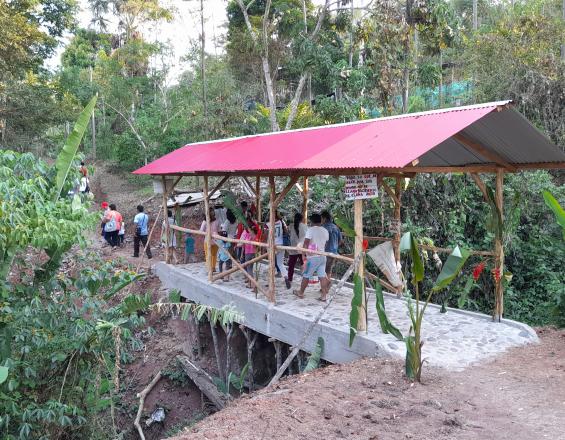
One of the main weaknesses of community tourism services is the lack of infrastructure to ensure a comfortable stay. This is due to the fact that there is no financing for this type of work, or that it is carried out without quality criteria.
To solve this problem, the project Sustainable Tourism and Protected Areas in a Post-COVID World in the Amarakaeri Communal Reserve and Rio Abiseo National Park (Peru), has chosen to develop the Cash-for-Work (CFW) mechanism, also known as the Fund for Jobs.
Through this mechanism, this weakness is transformed into an opportunity to create greater impact, offering temporary jobs to the residents of the 10 communities of both Protected Areas, in works that they themselves determined in their Community Action Plan. These have been financed 100% through the project.
This mechanism has strengthened local economies and, at the same time, has generated a greater sense of belonging.
Context
Challenges addressed
42% of Amarakaeri's inhabitants are involved in tourism. In Rio Abiseo, it is only 8%. Therefore, each Protected Area had a different challenge in terms of experience, participation and vision.
Amarakaeri has a population between 36 and 65 years old mainly (54.8%) dedicated to agriculture (86.3%), with an average monthly income between 40 and 100 USD, with a high participation in tourism (47.6%). With COVID-19, their job opportunities decreased (37.3%), as well as the flow of tourists to its main tourist attractions (73.8%).
The population in Río Abiseo fluctuates between 36 and 65 years of age (60.5%), dedicated to agriculture (45.9%), with an average monthly income between 40 and 100 USD. Unlike Amarakaeri, their link to tourism is low (6.8%). As a result of COVID-19, their employment opportunities decreased (65.7%), as did the flow of tourists to their main tourist attractions (64.4%).
Location
Process
Summary of the process
Quality assurance in Stage 1 (design-planning) was the key to Stage 2 (infrastructure development under the mechanism), in the following aspects:
- Methodology, from a multiperspectivity approach with the knowledge of those involved, and the respective testing with the team in the field,.
- Convening of community participants, with full knowledge of the commitments they will assume in the future.
- Plan construction workshop, where the articulating and prospective role of the project moderator is key to awaken and motivate all the creative variables that come into play in the planning process.
The critical point for the beginning of the works was the socialization of the resulting plan among those involved (as a transitory stage). This process, therefore, implied a visit to each community (with all the participants of the project) to socialize the results of the workshop and start projecting the execution of each work, but above all, the delegation (empowerment) of responsibilities within each group. The design of specific tools for this stage allowed for better follow-up and a sense of procedural order in the perception of the beneficiary communities.
Building Blocks
COMMUNITY ACTION PLAN
A participatory planning tool based on the following steps:
- Preparation: identification of actors (community leaders and managers of the territory), of previous agreements, and logistical preparation for the workshops.
- Plan constructionworkshop.
- Socialization of the Plan among the communities and managers.
During the Plan Construction Workshop, the participation of the communities involved (as a whole or through their elected representatives) and the managers of the territory is encouraged, with the accompaniment of the Project's technical team.
Thus, during this workshop (of approximately 8 hours), a Collective Dream of a 12-month scope is identified, linked to tourism within their territorial spaces, and that at the same time is consistent with the conservation efforts of their protected area.
Once the Collective Dream is identified, the participants determine:
- Objectives.
- Goals that allow them to measure the achievement of their objectives.
- Activities (and their respective responsible parties) that will make it possible to achieve their goals.
- Follow-upindicators to measure progress in the fulfillment of their activities.
- Responsible parties, both for goals and activities.
- Estimateddeadlines and dates.
- Resources, of the project, of the destination's agents and of the territory's own managers.
Enabling factors
- Tourism Use Plans being updated: this allowed the Community Action Plan to become a reference document for the sustainability of the tourist destination.
- Full Life Plans (in the case of the Amarakaeri CR) in the process of being updated: this allows the PACs to be a precedent in the identification of the vision and needs of the native communities.
- Involvement of the communities and managers: this allowed for active collaboration as the main characteristic of the governance of a territory with a vocation for sustainable tourism.
Lesson learned
In the process of designing the Community Action Plan, a methodology was developed that required validation by those involved in the project and transfer with the team in charge of field work. To this end, the developing versions of the methodology were socialized and perspectives were aligned among all those involved in this stage, giving priority to the conservation approach and community tourism as a high-impact tool that promotes capitalizable economic income from the knowledge of the participating communities.
The implementation process required a convening stage, the challenge of which was representativeness; it also faced geographical distances and the time of the community representatives and managers.
For this, two formats were used (one for each PA): in the case of Río Abiseo, one in which 2 community representatives met in an 8-hour workshop; the other (Amarakaeri), in which the workshop format was carried out at the rate of one workshop per community. Both allowed for representation and assertive management of each workshop.
ALIGNMENT OF FUND-FOR-EMPLOYMENT MECHANISM
After the socialization and validation of the plan, the following steps are taken:
- Execution of the Plan:
- Meetings to prepare the budget for each work (with quotations). These included the formation of work teams, preparation and signing of lists of workers, letters of commitment (with agreement on a fixed payment) and schedules within the project's timeframe.
- FundManagement Process: The fund was distributed to the participating communities in the 2 PAs, covering the following expenditure categories:
- Purchase of community materials. Using the "Affidavit" tool for the economic payment received by the community members providing these materials.
- Purchase of construction materials (not available in the community). For this purpose, the payment vouchers were considered as means of verification, together with a Materials Delivery Record.
- Payment of local labor: a distinctive element of this mechanism that made it possible to recognize the time and effort of each inhabitant in the construction that their own community identified in their plan. To achieve this, the following tools were designed:
- Letters of commitment, with the workday of each settler.
- Work follow-up card, with the control of the time worked by each inhabitant.
Affidavit of receipt of payment.
Enabling factors
The limited access to other sources of local income (labor vulnerability) allowed the involvement of people around the identified works. In addition, the openness of the beneficiary communities was key to the sustained development of each project.
In some communities, the participation of their local and community authorities was key, giving legitimacy to the works. It should be noted that during this process, neither children nor adolescents (members of the participating families) were involved in the work.
Lesson learned
The works developed thanks to the Fund-for-Employment mechanism had to be in line with a tourism product vision; that is, in addition to benefiting the community (in terms of usability), they had to fit in with the tourism experience proposals developed for each community. The articulating and permanent monitoring role of the Field Officers ensured that the works were carried out within the estimated deadlines, under the principles of transparency, flexibility and assertive communication.
Within each community, a "Master Builder" was chosen to guide the quality of the work performed; in addition, the project provided information and reference models for the implementation of the works.
The transfer of materials was a major challenge, due to the abrupt weather changes suffered by both PAs, as a result of global warming and the instability of rainfall. Prevention and permanent communication were the keys to overcoming this obstacle.
Impacts
Communities of the Abiseo River National Park
- San Juan del Abiseo: 1 visitor's reception house. 17 people directly benefited and 180 indirect beneficiaries.
- Pizarro: 1 accessible tourist viewpoint. 28 people directly benefited and 600 indirect beneficiaries.
- Pucallpillo: Renovation of 3 bridges. 30 people directly benefited and 150 indirect beneficiaries.
- Santa Rosa: Improvement of access to the local Botanical Garden, 1 artisan oven. 22 people directly benefited and 50 indirect beneficiaries.
- Dos de Mayo: 1 bridge. 20 people directly benefited and 2000 indirect community beneficiaries.
Communities of the Amarakaeri Communal Reserve.
- Queros: 6 new roofs for houses, and new foundations for the "Aguajal" tourist bridge. 26 people directly benefited and 30 indirect beneficiaries.
- Shintuya: 1 sanitary pit and 6 waste reception huts. 36 people directly benefited and 300 indirect beneficiaries.
- Puerto Azul Mberowe: 1 community dining room. 15 people directly benefited and 60 indirect beneficiaries.
- Boca Isiriwe: 1 visitor reception center. 26 people directly benefited and 45 indirect beneficiaries.
- Barranco Chico: Planting of 200 ornamental and production plants. 25 people directly benefited and 45 indirect beneficiaries.
Beneficiaries
Río Abiseo National Park -117 people:
- San Juan del Abiseo: 17
- Pizarro: 28
- Pucallpillo: 30
- Santa Rosa: 22
- Dos de Mayo: 20
Amarakaeri Communal Reserve -128 people:
- Queros: 26
- Shintuya: 36
- Puerto Azul: 15
- Isiriwe Mouth: 26
- Barranco Chico: 25
Sustainable Development Goals
Story
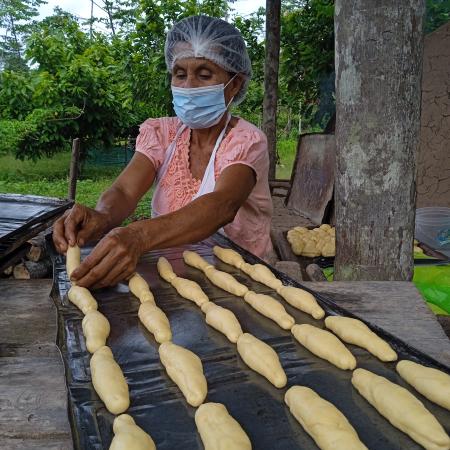
Clara del Águila is a farmer and artisan baker from the community of Santa Rosa (Río Abiseo NP). Part of the livelihood she supports her family with is the sale of artisan bread, but since she does not have her own oven or equipment in good condition, she rents a space from a local family for her daily production. This caused her a lot of uncertainty, since she did not know how long she would be able to continue this activity and contribute economically to her household.
In 2021, her husband, Wilfredo Caballero, died of COVID-19. He was the one who, through agriculture, provided the main income for the household. With his departure, Clara was left alone with her son José, a meningitis patient, and an increasingly bleak future. In fact, José's illness required constant medical attention, incurring greater expenses that, with Wilfredo's departure, were more complicated to cover.
One of the strategies of the "Sustainable Tourism in Protected Areas in a post COVID World" Project, led by Planeterra and IUCN, was to develop a Community Action Plan, in which each community and its managers identified by consensus what infrastructure was needed and whose construction would generate temporary employment.
Thus, in Santa Rosa, the decision was made to dedicate part of the funds from this mechanism to the construction of a new oven for Clara and the development of an artisan bakery near her home.
In this way, Clara could not only turn the sale of artisanal breads into a more secure source of income and offer better quality products to the community, but also, her knowledge and skills would allow her to integrate into the tourist circuit of Santa Rosa, allowing not only the tasting, but also the participation in an artisanal bakery experience in the middle of the Amazon for visitors: a value that gives Clara and her community a competitive advantage within the Abiseo River National Park.
During this process, she and her son also generated economic income by being part of the construction of their infrastructure. Thanks to this, Clara can face the future with greater security, José can have better health care opportunities, and in turn, continue with an activity that they are passionate about and that empowers them every day.

